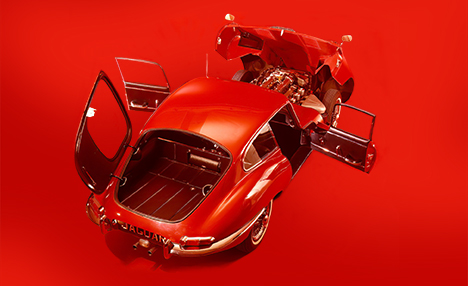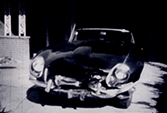Sports cars have never been the primary aim of Jaguar. They certainly fill a niche in a the market, but saloon cars have been the bread and butter. Fortunately, William Lyons’ pursuit of the perfect luxury car provided the basis for a series of perfect sport cars. Lyons’ dream of a smooth, 100 mph car demanded an engine capable of producing large amounts of horsepower and torque with complete reliability. To this end, the Jaguar engineers, with the help of Harry Weslake, developed the famous XK twin cam engine.
When it was realized that the new engine (and a concurrently designed chassis) would not be clothed in time for the 1948 Earl’s Court Motor Show, a quick decision was made to design a sports car to show off the new engine. A crash development program taking literally no more than a few weeks resulted in the XK120 show car. Jaguar never looked back. Each succeeding model was more refined. The E-Type combined a sedan-like ride with sports car performance.
Ultimately, the V12 engine (once again designed for a sedan) was fit into the E-Type to ward off the effects of emission controls. The next sports model would be less concerned with pure grunt. The XJS represents a different approach. Jaguar customers today want silence and weather protection first. Wind-in-the-hair has lost the appeal it once had. We’ve asked the drivers of three generations of sporting Jaguars to give a little insight into what their particular car offers, above and beyond mere transportation. The responses are indicative of how each generation of Jaguar captivates its audience with a combination of grace and refinement.
XK120, by Steve Duncan: Steve is a long time Jaguar admirer from eastern Washington. He’s pictured here his 1954 XK120 at the Palonse Car Parade, which took place on August 31, 1986.
All the Jaguar XK series cars are truly lovely. The XK120, producer from 1949 to 1954, was the lightest, perhaps the most sporty and certainly the series’ purest form. The XK140 and the XK150 became increasingly more refined. Eventually, large bumpers, extra chrome trim, softened body lines and roll-up windows (even on the roadsters) were introduced. The original XK120 remains my first choice because of its historical impact and the uncompromised designed. However, I would like to have one of each.
XK120 production totaled 12.1178 before the XK140 was introduced. Roadsters accounted for more than half of these, while only 1.765 drop head coupes were produced. The XK120 was recognized as revolutionary for unusual reasons. The beautiful dual overhead camshaft engine was impressive but certainly not a first. The torsion bar independent front suspension with ball joints was fairly new, having appeared previously on the Jaguar Mk V Saloon. Beautiful leather graced the interior, and the car rode with a supple smoothness previously unknown to British spurts cars. What really made the 120 revolutionary was the price. Never before had a sports car of such magnificent specification been offered at so low a price. This was, of course, William Lyons’ continuing secret to success.
The roadster pictured here was found abandoned in an Eastern Washington wheat field and was purchased for $850. It was a basket case in every sense of the word. The engine and transmission were missing, as well as nearly the entire interior. After trailering the sad looking mess home, a six-year restoration began.
Driving the reborn cat can only be described as exhilarating. Once settled in the confines of the 120, I savor the process of starting the engine. Of course, the gear lever must be in neutral and the handbrake locked before the key is turned. I listen as the SU fuel pump settles into a rhythmic clicking. Finally, I push the starter button and the great XK engine springs to life. (All cars should have starter buttons as some British sports cars do!) The engine relaxes to an even gait as the oil pressure rises to its expected level. I enjoy listening to this music while waiting for the water temperature needle to move the first small increment. The gear lever clicks into place and it’s time to travel.
Finding words to accurately describe the experience of driving the 120 is difficult. At 6’2″, although not particularly comfortable, I try to appear so. Sitting low in the seat I peer over the windshield, not through it. Thighs rub against the large wheel and elbows hang out. My feet are never really satisfied. Nonetheless, the engine sounds positively intoxicating and, after all, the bugs are not too difficult to remove from my forehead. People constantly wave or roll windows down to comment. For me, the beautiful Jaguar XK120 represents what open air motoring is all about!
E-Type, by Robert Goldman: Hob uses “whichever car runs this week.’ Sometimes, he’s forced to borrow the Jag because all of his own cars have mysteriously broken.
Jaguar’s XKI20-150 series were sensational cars when first Introduced, but by 1900 it was obvious that a replacement was on the way. Any new Jaguar would have a tough act lo follow. The XK series had little that one could find fault with, and now Jaguar was expected to produce something even better.
Malcolm Sayer’s brilliant body styling, combined with monocoque construction and four wheel independent suspension added up to a car known as the E-Type. Once again the Jaguar was unveiled too overwhelming public approval. The only liability (which certainly seemed innocent enough at the time) was a claimed ISO mph top speed. William Lyons’ insistence on reaching the magic 150 mark led Jaguar to build a special car for the magazine reviewers. The car went 150 mph as expected, but it was equipped with some non-standard body materials and had an extensively tuned engine. Ever after, Jaguar suffered through endless complaints about standard cars that would not go the advertised speed.
Upon completion of his first automotive childhood (somewhere in his early forties), my father decided it was
high time to buy a “grownup” sports car. A rare 1969 two seat coupe turned up in the driveway one afternoon, and I was hooked. My sister and I were each given our first-ever 100 mph car ride, but it would be many years before I had my chance to drive. When the time came, my expectations were rewarded by reality. 1 for one, have never driven another car which produces such a an elegant ride while still giving the Impression of being stuck to the road.
The word impression is important here. Although the car handles reasonably well, we must bear in mind the sheer physical bulk of the engine, the amount of power available, and those skinny little 185/15 tires. An E-Type will alternately steer from the front, or back. One can control this with judicious use of the throttle, but let’s face it, as a card carrying member of the young and restless, I tended to drive fast cars like a light switch—on or off. Part throttle was a concept yet to be discovered.
The car survived my early exploits and still runs well despite its worn nut Stromberg carbs. Contrary to popular belief, E-Types are not difficult to maintain, but the cost of spares is daunting to those of us weaned on MGs and TRs. Like the XK series before it, the E-Type eventually fell victim to changing times. Timeless styling and magnificent performance are meaningless in the face of safety and emission regulations. Ultimately, the prospect of mandated roll-over protection and a general trend toward comfort led Jaguar in an entirely new direction. I’m not knocking the XJS, but I hope there are still a few E-Types left when I “grow up.” I like wind in the hair, exhaust noise and manual transmissions. Perhaps the much rumored F-Type will be as good a value as its ancestors.
XJS, by Carcy Kendall: Carey has been a salesman at Moss Jaguar since I9S2. His high regard for the car is in no way related to the fact that he sells them for a living.
So many people use the term Grand Touring in reference to motorcars in an almost casual vein, and yet they Jaguar XJS embodies all the characteristics and requirements of such a car. It is absolutely luxurious. The fine woods and the smell of the Connolley hide surround you inside the cabin. I have often heard it compared to driving an English club down the road. It is utterly quiet—at 20 mph or at higher speeds (up to nearly 150 mph) it is certainly capable of obtaining. The ride quality is perhaps unparalleled. Not only does Jaguar’s suspension take the XJS through corners with grace, but it has an uncanny ability to smooth out bumps. This is a very difficult engineering feat to achieve and one carried out very well in the “S”.
The XJS came into being as the evolution of the E-Type sports car Jaguar produced in the 1960s and the early 1970s. With the advent of legislation in the United States regarding roll over protection, Jaguar, along with many other manufacturers, thought the days of the convertible were numbered. The XJS was controversial at the beginning, and I find it still evokes strong comment—both for and against. Personally, I think in the right colors it evokes a very “cat-like” feel—low, sleek, understated and quite beautiful. It brought the E-Type sports car to the level of Grand Touring car. One characteristic totally different from its predecessors is the lack of engine sound. Whereas the sports cars that Jaguar once produced were commonly noted for their beautiful exhaust note, the XJS is commonly known and recognized for its silence.
In 1982, Jaguar reintroduced the XJS in the United States, after an almost two-year absence. The car had built a very poor reputation for reliability from its inception, and the new leader of Jaguar, John Egan, withdrew it from the market until it could be redesigned. A “re-release” in 1982 saw the car equipped with the now famous Michael May designed “HE” (high efficiency) cylinder head. The car had gone throughout a metamorphosis in a way. The interior was much more plush, the wheels had changed and there were countless mechanical improvements. The XJS has since proven as reliable as any of the other sophisticated cars in its class.
In the 1986 model year, XJS was introduced into the United States in the Cabriolet body style—a multitop configuration with the window frame and an integrated roll bar intact. A year alter a true full convertible with a power top was introduced. It is built from a coupe by Hess and Eisenhardt, a 100-year-old firm located in Ohio. The production so far has been very, very limited, but it has to be one of the most beautiful convertibles produced. The few times the Moss Jaguar has had one in the showroom it has gathered an instant crowd. It is a worthy successor to the E-Type roadster.
If you have the chance to ride in, or better still, to drive one of Jaguar’s XJS cars, do so. You will be in for a treat.







'Evolution of the Sporting Jaguar' has no comments
Be the first to comment this post!